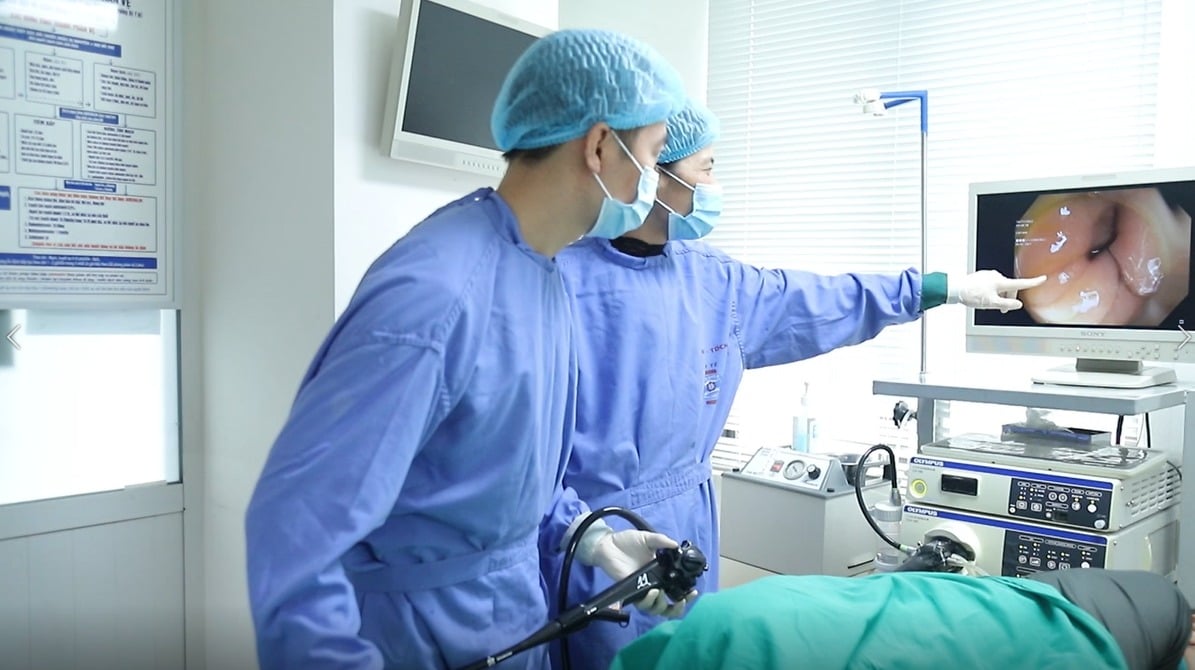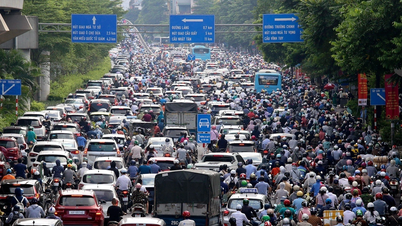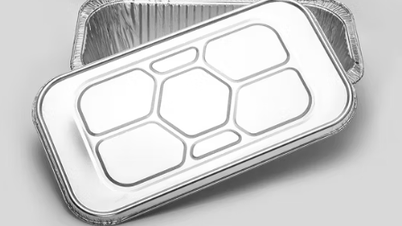At first, he thought it was just an age-related problem or a lifestyle issue, so he proactively monitored it at home and did not seek treatment. However, when the symptoms did not improve, his family encouraged him to go for a check-up.
Warning signs of colon cancer
At the medical facility, Mr. T. said he felt mild pain in the right lumbar region, dark urine but no burning or frequent urination, no fever, no abdominal pain, sometimes digestive disorders, going to the toilet 3-4 times/day, loose stools but no blood or mucus, no weight loss.
Illustration photo. |
Through clinical examination, the doctor noted no signs of infection or anemia, but there were signs of digestive disorders. The patient was ordered to undergo blood tests, ultrasound, endoscopy, CT scan, etc. to clarify the cause.
Colonoscopy results showed that in the sigmoid colon there was a jagged, crumbly lesion that bled easily when touched, about 4-5cm in size, occupying nearly 1/3 of the colon circumference.
The doctor performed an on-site biopsy, and the pathology results showed that Mr. T. had sigmoid colon cancer, moderately differentiated adenocarcinoma.
In addition to colon cancer, Mr. T. was also found to have a series of other underlying diseases such as kidney stones and bilateral ureteral stones, chronic hepatitis B, and early-stage chronic obstructive pulmonary disease (COPD).
Specifically, ultrasound recorded images of bilateral renal pelvis and ureteral dilatation due to ureteral stones in the upper third, accompanied by stones and cysts in both kidneys, and thin left renal parenchyma.
Hepatitis test showed positive HBsAg, high HBV-DNA, but liver stiffness was only at F0, liver had mild fatty degeneration grade I. Lung CT scan showed alveolar dilatation in both lungs, with upper lobe predominance, characteristic of early stage COPD. In addition, Mr. T. also had gastritis, esophagitis, and grade A gastroesophageal reflux.
After being diagnosed, according to his family's wishes, Mr. T. was transferred to a higher-level hospital for treatment. Here, he successfully underwent surgery to remove the colon tumor and is currently receiving adjuvant chemotherapy according to a 7-cycle regimen. He has completed the first 2 cycles, is in stable health, and eats and sleeps well.
Mr. T's family would like to thank the team of doctors at Medlatec Tay Ho for helping to detect the disease at an early stage, creating conditions for effective treatment and increasing the patient's chances of survival.
Mr. T's case is a clear example of how vague symptoms such as back pain or dark urine that are often overlooked can be warning signs of dangerous diseases.
If not checked early, many diseases will progress silently until it is too late to be detected. In the context of increasing gastrointestinal cancers in Vietnam, regular health check-ups play an extremely important role. According to statistics from Globocan in 2020, Vietnam recorded nearly 16,000 new cases of colon cancer each year, including more than 8,200 deaths.
This disease is common in people over 50 years old, but is increasingly younger due to unhealthy eating habits, stress, smoking, obesity, long-term medication use and lack of exercise.
Gastrointestinal cancers such as stomach, colon, rectum, esophagus, etc. often have no obvious symptoms in the early stages, but if detected early, the cure rate can reach 70-90%. On the contrary, if detected late, the 5-year survival rate is only less than 20%.
According to Dr. Le Van Khoa, a gastroenterologist at Medlatec Tay Ho, people should have a regular health check-up at least once a year, especially if they are in a high-risk group such as people over 40 years old, have relatives who have had digestive cancer, have chronic symptoms such as abdominal pain, bowel disorders, bloody stools, or have had stomach ulcers, colitis, Crohn's disease, etc.
Doctors also note that any unusual signs such as persistent back pain, changes in bowel habits, digestive disorders or dark urine should be checked as soon as possible.
A general health check-up not only helps detect diseases early, even when there are no symptoms, but also increases treatment effectiveness, prolongs life and reduces the burden of medical costs for patients and their families.
The technique or “reverse” shoulder joint helps patients move
After falling off her bike, Ms. A. (70 years old, Ho Chi Minh City) suffered a fracture of the upper end of her right humerus into many small pieces, causing severe pain even with the slightest movement. Doctors at Tam Anh General Hospital in Ho Chi Minh City successfully performed a modern “reverse” shoulder replacement surgery, helping her regain almost normal mobility after only one month.
According to Dr. Le Van Tuan, Director of the Orthopedic Trauma Center, Tam Anh General Hospital, Ho Chi Minh City, the upper end of the humerus is an important part that makes up the shoulder joint, one of the joints with the largest range of motion in the body.
When there is a fracture, especially a complex fracture, even the smallest movement causes severe pain. The shoulder joint also contains many large nerves and blood vessels. If not treated promptly, the broken bone fragments can cause damage or compression, damaging the vascular system that nourishes the arm, even causing permanent paralysis.
Normally, for fractures, doctors will prioritize the method of bone fixation with screws, if the bone quality allows. However, in Ms. Anh's case, this technique cannot be applied because the bone head is broken into 4-5 small pieces, the humeral head bone is very little left, and severe osteoporosis does not have enough foundation to hold the screws. In that context, reverse shoulder replacement is the most feasible option.
The “inverted” shoulder is a special design in which the positions of the glenoid and humeral head are swapped, providing increased stability and range of motion for the patient.
This design is especially effective for the elderly, where the ligaments, joint capsule, and rotator cuff tendons are often degenerated, torn, or weakened. This type of artificial joint not only helps to correct shoulder instability but also reduces the risk of post-operative dislocation.
Before surgery, because the patient was old and had many underlying diseases such as diabetes, high blood pressure, osteoporosis and a history of cancer, the surgery was carefully planned with the coordination of many specialties.
Doctors have controlled the internal diseases to limit complications during and after surgery. At the same time, specialized software TraumaCad is used to process data from X-rays and CT, calculating the size of the artificial shoulder joint that best fits the patient's anatomical structure.
The three-hour surgery was performed with great care. The surgeons removed all the broken bone and damaged tissue, then reassembled the shoulder and tested its stability by rotating the arm in different directions. Finally, the soft tissue and muscles were reconstructed, the incision was closed, and the procedure was completed.
After surgery, Ms. Anh was alert, had significantly reduced pain, and began rehabilitation exercises on the first day. After a month, she was able to move her shoulder almost normally. She will continue to be monitored and have individualized rehabilitation exercises for 3-6 months to prevent complications such as joint adhesions, muscle atrophy, or osteoporosis around the joint.
MSc. Dr. Ho Van Duy An, Orthopedic Trauma Center, Tam Anh General Hospital, Ho Chi Minh City, said that osteoporosis is the leading cause of bone fractures in the elderly.
Even a slight collision in daily activities can lead to bone fractures, especially in large joints such as the hips, shoulders, and wrists. If not treated early and properly, the patient may face serious consequences such as chronic pain, loss of motor function, venous thrombosis, pressure ulcers, etc.
Currently, Tam Anh General Hospital in Ho Chi Minh City is implementing the program "Emergency treatment for bone fractures within 24-48 hours" with a synchronized, fast and accurate process. Patients with bone fractures will be examined preoperatively using modern machinery systems such as 3 Tesla MRI, 1975-slice CT, echocardiography and automatic testing systems.
If eligible, the patient is indicated for surgery within 24-48 hours of admission, the “golden” time for the most effective intervention. The sooner the surgery, the less pain, faster recovery and reduced risk of complications.
Drinking alcohol every day, almost paying with life due to acute pancreatitis
The Central Hospital for Tropical Diseases admitted a patient with acute necrotizing pancreatitis in critical condition due to long-term alcoholism. The patient is Mr. TVT, 46 years old, residing in Hanoi , with a history of alcohol use for many years with an average dose of about 500 ml per day. Although he had been hospitalized many times for pancreatitis, he still could not give up drinking.
This time, Mr. T. was taken to the hospital by his family with severe pain in the epigastric region, pain radiating to the back, nausea and bloating - typical symptoms of severe acute pancreatitis. Test results showed that pancreatic enzymes in the blood were 10 times higher than normal. Worryingly, the blood fat index (triglyceride) skyrocketed to 16 mmol/L, while the safe threshold is only between 0.7 and 1.8 mmol/L.
Master, Doctor Nguyen Kim Anh, Department of Emergency, Central Hospital for Tropical Diseases, said that the results of abdominal CT scan showed widespread inflammation of the pancreas, many pus pockets around the pancreas and severe necrosis. This is the most serious level of acute pancreatitis, which can lead to shock, multiple organ failure and death if not treated urgently.
The patient was prescribed intensive treatment including: complete fasting to rest the pancreas, intravenous fluids, insulin to reduce triglycerides, pancreatic secretion inhibitors, pain relievers and high doses of anti-inflammatory drugs.
Thanks to timely detection and intervention, after two days of treatment, the patient was alert, no longer had abdominal pain and did not need surgery. However, doctors warned that the possibility of relapse would be very high if the patient did not abstain from alcohol completely and strictly control blood lipids.
Dr. Kim Anh said that acute pancreatitis is one of the most dangerous medical emergencies, and can go from abdominal pain to shock and organ failure in just a few hours.
The three most common causes of acute pancreatitis are prolonged alcohol consumption, metabolic disorders, especially hyperlipidemia, and biliary obstruction due to stones. Many patients, after stable treatment, return to drinking habits or stop treatment, leading to repeated relapses and chronic pancreatic damage, pancreatic necrosis, infections, and dangerous complications such as diabetes, digestive disorders, and malnutrition.
There are cases so severe that blood tests show separation, the upper layer is milky white fat, the lower layer is blood. The pancreatic fluid drained out is thick and foul-smelling due to necrosis and severe infection. Such cases require prolonged resuscitation, intervention to drain the inflammatory fluid, even surgery, and the prognosis for survival is very poor.
Doctors warn that acute pancreatitis is not only a direct consequence of alcohol but also a sign that the digestive and metabolic systems are seriously overloaded. People with symptoms of epigastric pain radiating to the back, nausea, bloating, loss of appetite, especially those who regularly drink alcohol or have dyslipidemia, need to go to the hospital as soon as possible for timely examination and treatment.
In the treatment of acute pancreatitis, time is of the essence. The earlier the diagnosis and intervention, the greater the chance of survival; a delay of just a few hours can cause irreversible damage.
Source: https://baodautu.vn/tin-moi-y-te-ngay-206-dau-hieu-canh-bao-ung-thu-dai-trang-d308751.html








































































































Comment (0)